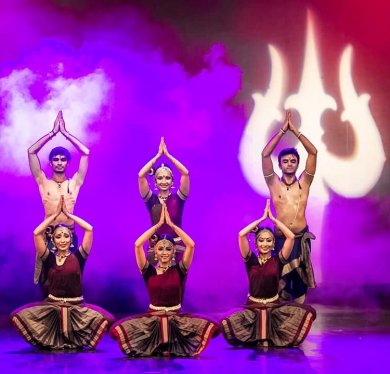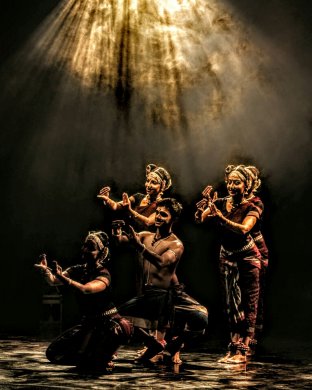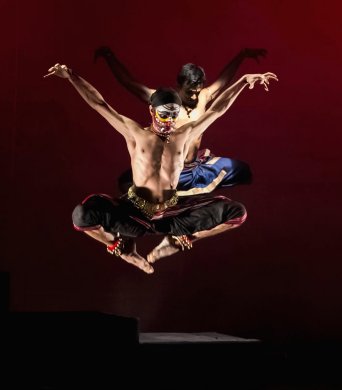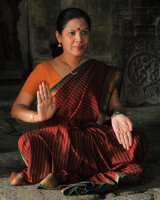
|   |

|   |
Hara: When the Gods dance - An analytical report - Ramaa Bharadvaj e-mail: ramaabharadvaj@gmail.com Photos: Narayanan Vinoba October 11, 2015 Luminosity! In astronomical terms it refers to both the visual as well as radiant energy emanating from a star. In that sense, both the production HARA, by the Punyah Dance Company (premiered in Bangalore in September 2015) and its star performer Parshwanath Upadhye ranked high on the luminosity quotient. The evening drew an eager audience. The young girl sitting next to me, for example, had travelled with her family more than 350 kms from Coimbatore just to attend the premiere. “I am a huge fan,” she declared with a dreamy sigh. And for such an adoring audience HARA did not disappoint.  Although billed as “an amalgamation of the legends of Siva”, HARA’s focus was only on one story from among the Siva myths, and a commonplace one at that - the one of Siva, Sati and Parvati triad. But can a common story/theme be made to feel fresh and original? HARA’s creative team seemed to have taken this challenge seriously. Through skillful scripting, development of sub-plots and deft character portrayals they took this production out of what could have otherwise loitered around in a tedious déjà-vu range. The celebration began in the lobby of Rangamandira Auditorium with nadaswaram and tavil artists to draw attention to the pradosha time of sunset, auspicious to Siva. The ambience continued on stage as the curtains parted to a prayerful mood. Clad in deep red and black costumes sans any sparkle and sparse accessories that tastefully incorporated Rudraksha beads (designed by Shankar Deju) the ensemble visually embodied the austerity that is associated with Siva. A gobo projection that alternated between a trident and a crescent moon along with gently restrained lighting (P. Vinaychandra) kept the stage aesthetically uncluttered. And that was a good thing because it was the dance that took center-stage as this well rehearsed group of 6 friends began to tell the story. They each took on several roles with no costume changes or even suggestive add-ons. Their dance was sufficient to take them in and out of multiple characters effectively. After an invocation that showcased their group dynamics with pizzazz, the story moved to the amorous moments of the couple Siva and Sati - an “Awww” inducing scene in which Siva asks Sati to groom his hair and they dress each other up. Now if that doesn’t make you smile! This union doesn’t have a “happily ever after” ending, for Sati leaves, uninvited, to attend her father Daksha’s Yaga festivities with a tragic end. The story of Sati and Siva appears grim on the surface, complete with a self-immolation and a gruesome decapitation. But underneath all this, there actually shimmers a tale that highlights yogic powers and transcendence of the physical. Choreographies that simply skim the surface run the danger of turning it into nothing more than a violent saga and the thing with violence is that if you watch it frequently enough without asking questions, you become numb to it. But Parshwanath has thought deeply about the subject. “I always wondered why such a strong woman would end her life! All the popular explanations failed to convince me. So I came up with my own.” His depiction was dignified - the soul merging with Siva, the Consciousness and the body with Siva, the Agni - and AT WILL! Through a briefly held gesture, Parshwanath made this concept clearly visible - it was just one of the many engaging choreographic moments abounding in this production. Parshwanath as Siva did not don brass snakes, wear dreadlocks or drape himself with faux tiger skin. Heck, there was not even a vibhooti stripe on his forehead! But his Siva-ness was unmissable. He has great agility and technical virtuosity, but does not resort to displaying them like a gymnastic show with impossible splits or twists. It is a very possible Bharatanatyam adavu that takes on glorious colors when it enters his body. He executes ordinary dance patterns in an extraordinary way thus drawing attention to the power of practice. During the beautiful song “Shambo Shankara Siva,” written and tuned beautifully by the dancer himself, he seemed to float in space through a series of forward and backward aerial kicks of the legs at lightning speed drawing thunderous applause from the astounded audience. Yes, this Siva needed no costumes. His dance was attire enough. Shruti Upadhye as Sati was sweetness personified whether she was engaging in a competition with Nandi, the bull, for Siva’s attention, or begging to attend her father’s Yaga celebrations. The on-stage chemistry of this real life couple is an image straight from fairy tales. Matangi Prasan was an adorable Nandi-Bull. With her look of big eyed innocence and light-footed leaps (she moves with such precision and ease) she made a great vehicle for the ever-dancing Siva. The threesome created some humorous moments with Siva the “workaholic” husband who has to be reminded by Sati - “Hello! Remember me? Your wife?” - and Nandi as the mediator in their tiff. Tall and elegant Preethi Bharadwaj’s eyes spewed flames in her portrayal of Sati’s father Daksha. There were never any over-exaggerated expressions, but her fierceness was capable of sending shivers. P.V. Aditya made a formidable Veerabhadra. His masklike face-painting gave just enough mystery to this warrior entity. The transference of energy from Siva to Veerabhadra was a compelling moment shown through a fistful of sacred ash and a clever exchange of dance space between Siva and his warrior energy. The dark contours of the latter are brought into the light and the former recedes into a dusky silhouette. While mirroring each other in their frenzied dance, Aditya brought just a touch of detached ferociousness to contrast the grief that tinted Parshwanath’s Siva. This use of foreground versus background was artfully used once again when Veerabhadra beheads Daksha. This added layered horror, instead of an insipid literal depiction 

As the first part of the story ends, we see Siva with the lifeless body of Sati, offering himself to be groomed by her again, in reminiscence of their joyous days. Unfortunately however, this scene did not even come close to its potential. It was portrayed in such distracted hurriedness that it snatched a great deal away from the poignancy of the scene. Not that it needed any melodrama, but it certainly needed time and stillness to hold on to. I hope Parshwanath will rethink this critical transition scene in his next performance. The rebirth of Sati as Parvati was a dramatic introduction in which, through a slow shifting of light hues and use of soundscape we were brought into another lifetime. Fortunately, the choreographic team did not resort to the easy way out of casting the same dancer who portrayed Sati to appear as Parvati. Their creativity once again came to the forefront in their choice of lovely Sneha Devanandan for the role. Siva who initially shuns the attempts by Parvati to win his love finally accepts her. Here, what you would think only a camera-effect could achieve on screen was portrayed on stage cleverly as we behold Parvati through the eyes of Siva who recognizes Sati in her. Another enchanting choreographic moment! The normal portrayal of Siva in meditation and Cupid arriving to awaken him and getting incinerated do not physically happen in HARA. Instead, we see Siva as his wandering mind that is lured by the illusory charms created by Cupid. The story receives a symbolic flavor with Siva realizing this and burning all his inner desires (ari shad vargas of lust, anger, delusion, greed, pride and jealousy). “We presented Cupid as a concept and not as a person,” explained Parshwanath to me. This symbolism however did not choreographically translate clearly on stage. It remained a concept. Siva appearing as a mendicant to test the love of Parvati was an engaging sequence where their “conversation” was given great attention to, once again attesting to skillful story development. HARA ended serenely with abhishekam and sacred offerings to the small Sivalingam at the stage corner - a sacred conclusion to a sacred and satisfying evening. G. Srikanth’s impressive music composition and bhava laden singing and Kartik Datar’s musical arrangement added great impact to HARA’s overall effect. The musical use of sections from Siva Manasa Stotram, Margabandhu Stotram, Tiruvacagam were sublime to the ears. One refinement that could be considered in the staging of HARA is to rethink the over use of the fog machine. The production opened with dancers holding clay pots from which wafted sambirani vapors that unobtrusively filled the stage, thus creating an atmosphere of haze needed for streaks of light to dance upon. “How inventive!” I thought. But later, they resorted to puffs and puffs of smoke which only managed to fog the stage in uneven thick patches obscuring the dancers at all the wrong times. Many times, it had the look of a choking car exhaust rather than create a magical mood. These contraptions are more suitable for large stages with sufficient depth or for movie sets and the direction of their fog flow is also dependant on the air flow and temperature of the stage area. I asked Parshwanath what his challenge was in creating HARA. As expected, the answer was that of not being able to find financial backing. “So we decided to self-fund,” he said. Instead of resorting to corporate sponsorships and then giving away free tickets, Punyah Dance Company took their dance AND their audience seriously. With donor passes at Rs.1000, Rs.500, Rs.300 and Rs.200, they nearly sold out two back to back performances. This is testimony that audiences for classical dance performances are not dwindling and that classical dance can magnetically draw youth to pay to watch performances when presented radiantly. With intelligent scripting and commitment to professional quality, the rapport between rasika and classical dance is now, and shall in future, remain alive and well.  Ramaa Bharadvaj is a Lester Horton Award winning dancer, choreographer, published author and dance-commentator. After 31 years of a successful dance career in the US, she returned to India and divides her time between Bangalore and Kolwan (Maharashtra) where she works as the Director of Dance at Chinmaya Naada Bindu Gurukul-Ashram for Performing Arts. |